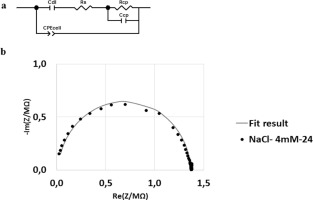Journal of Colloid and Interface Science ( IF 9.9 ) Pub Date : 2018-05-29 , DOI: 10.1016/j.jcis.2018.05.071 Mohammad Yaser Khani Meynaq 1 , Britta Lindholm-Sethson 1 , Solomon Tesfalidet 1

|
Hypothesis
Electrochemical impedance spectroscopy is useful to monitor anionic interactions with a Lipid Cubic Phase, as previously demonstrated for cationic interaction (Khani Meynaq et al., 2016). It was expected that the smaller hydrophilic anions, acetate and chloride, would interact differently than the large tryptophan anion with its hydrophobic tail.
Experiment
The impedance measurements enabled estimation of resistances and capacitances of a freestanding lipid cubic phase membrane at exposure to 4 and 40 mM solutions of NaCl, NaOAc and NaTrp. Small-angle X-ray scattering was used for cubic phase identification and to track structural changes within the cubic phase when exposed to the different electrolytes.
Findings
The membrane resistance increases at exposure to the electrolytes in the order Cl− < OAc− < Trp−. The membrane resistance decreases with time at exposure to the hydrophilic anions and increases with time at Trp− exposure. The membrane capacitances were lower for NaTrp compared to NaCl and NaOAc at the corresponding concentrations which is consistent with the results from SAXRD. It is concluded that Trp− ions do not enter the aqueous channels of the cubic phase but are strongly adsorbed to the membrane/electrolyte interface leading to large alteration of the lipid phase structure and a high membrane resistance.
中文翻译:

阴离子与脂质立方相膜的相互作用,电化学阻抗研究
假设
电化学阻抗谱可用于监测阴离子与脂质立方相的相互作用,如先前对阳离子相互作用所证明的那样(Khani Meynaq 等人,2016 年)。预计较小的亲水阴离子乙酸根和氯离子与具有疏水尾的大色氨酸阴离子的相互作用不同。
实验
阻抗测量能够估计独立脂质立方相膜在暴露于 4 和 40 mM NaCl、NaOAc 和 NaTrp 溶液时的电阻和电容。小角 X 射线散射用于立方相识别,并在暴露于不同电解质时跟踪立方相内的结构变化。
发现
暴露于电解质时,膜电阻按 Cl - < OAc - < Trp -的顺序增加。膜电阻在暴露于亲水性阴离子时随时间降低,而在 Trp -暴露时随时间增加。与相应浓度的 NaCl 和 NaOAc 相比,NaTrp 的膜电容较低,这与 SAXRD 的结果一致。得出的结论是,Trp -离子不会进入立方相的水通道,但会强烈吸附到膜/电解质界面,导致脂质相结构发生较大变化和膜电阻高。


























 京公网安备 11010802027423号
京公网安备 11010802027423号